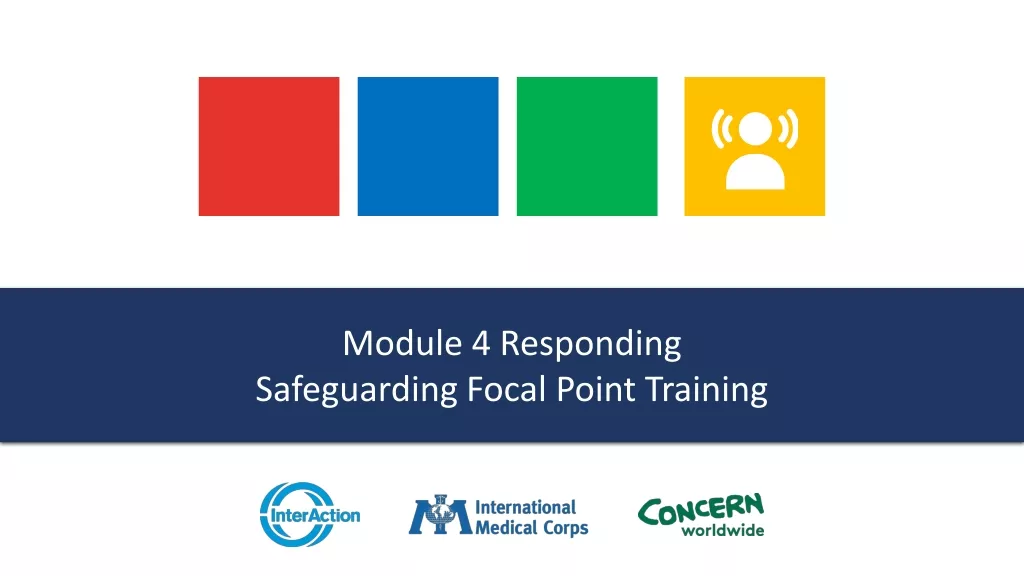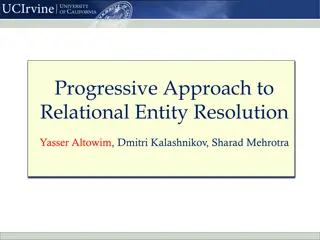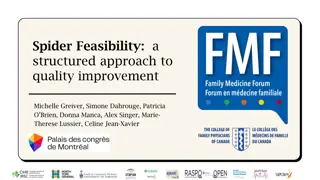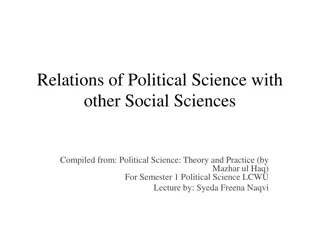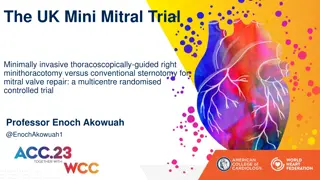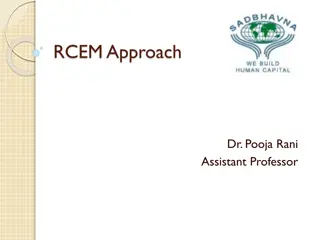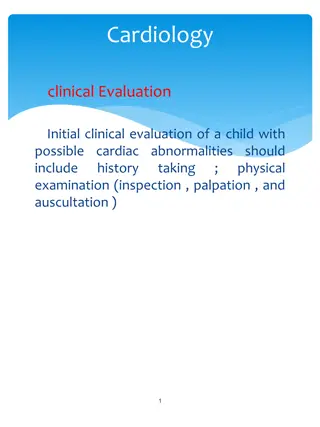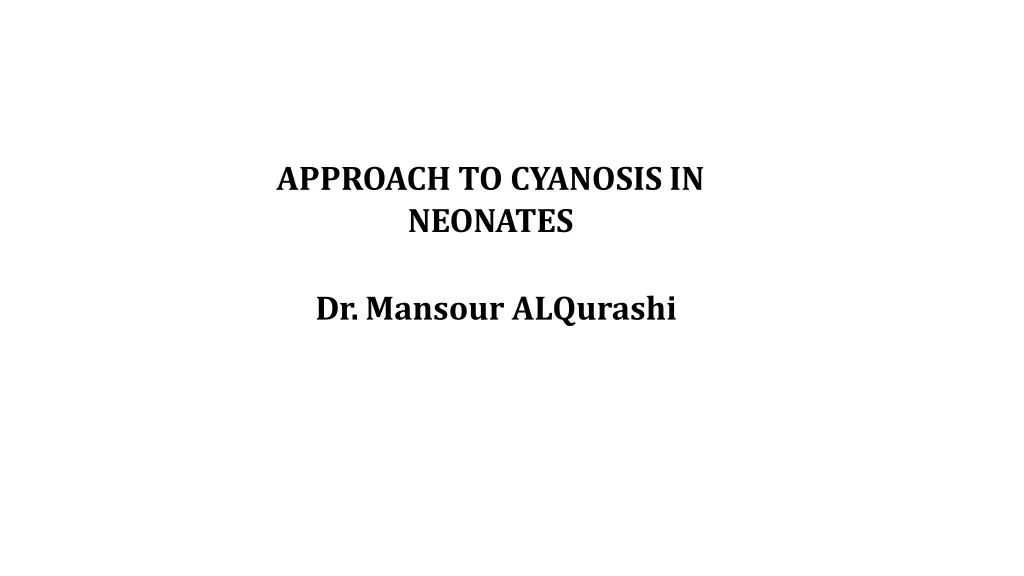
Approach to Cyanosis in Neonates: Steps for Diagnosis and Management
Learn about the comprehensive approach to assessing cyanosis in neonates, including key steps for diagnosing cardiac disease, interpreting CXR findings, evaluating CO2 retention, conducting hyperoxia tests, and identifying PDA-dependent cardiac lesions. Confirmatory diagnostic tools like ECG, echocardiography, and cardiac catheterization are essential in diagnosing conditions such as persistent pulmonary hypertension of the newborn (PPHN).
Download Presentation

Please find below an Image/Link to download the presentation.
The content on the website is provided AS IS for your information and personal use only. It may not be sold, licensed, or shared on other websites without obtaining consent from the author. If you encounter any issues during the download, it is possible that the publisher has removed the file from their server.
You are allowed to download the files provided on this website for personal or commercial use, subject to the condition that they are used lawfully. All files are the property of their respective owners.
The content on the website is provided AS IS for your information and personal use only. It may not be sold, licensed, or shared on other websites without obtaining consent from the author.
E N D
Presentation Transcript
APPROACH TO CYANOSIS IN NEONATES Dr. Mansour ALQurashi
Steps for diagnosis of cardiac disease in a neonate Step 1: cyanosis detection. Is your baby cyanotic? Yes or No Is cyanosis due to cardiac or pulmonary disease?
Cyanosis & CXR: CXR may suggest lung disease particularly if the findings are asymmetrical. If the changes are diffuse and symmetric i.e. compatible with pulmonary edema or increased PVM, it is difficult to differentiate between 1ry lung disease or heart disease causing pulmonary edema e.g. TAPVD with obstruction. PPH can coexist with lung disease and cause severe cyanosis.
Cyanosis and CO2 retention CO2 retention is usually prominent with 1ry lung disease. Some severely cyanotic infants with cardiac disease can have marked hypercarbia. Absence of hypercarbia is suggestive of cardiac disease. Some severely cyanotic infants with pulmonary vascular disease have normal PCO2.
Cyanosis & Hyperoxia Test It is the response of the arterial PO2 to administration of 100% O2. If PO2 goes above 220 mmHg the patient has lung disease. If PO2 is less than 100 mmHg the patient is likely to have cardiac disease. The test is inconclusive if PO2 is between 100 and 220 mmHg. Transcutaneous O2 saturation is NOT an alternative to arterial PO2.
PDA Dependant Cardiac Lesions RVOT Obstruction: e.g. TA, PA, or Severe TOF +/- PA. They manifest with severe cyanosis when the pulmonary flow is compromized by a closing DA. LVOT Obstruction: e.g. HLHS, Critical AS, Hypoplastic AA, or severe Co A. They manifest with early CHF as their descending aorta flow is supplied by PDA. D-TGA: as PDA is needed for proper mixing of pulmonary and systemic circulations.
Confirmatory Diagnostic Tools ECG Echocardiography with Doppler. Diagnostic Cardiac Catheterization.
Persistent Pulmonary Hypertension of the newborn (PPHN) PPHN is defined as delay in the normal postnatal decline in pulmonary vascular resistance resulting in associated shunting of de-oxygenated blood across to the systemic circulation, leading to arterial hypoxemia PPHN (or persistence of the fetal circulation) occurs in approximately 1 in 1500 live births
Primary PPHN Classical PPHN idiopathic Hypoxemia develops in a baby with normal lungs. Breath sounds and CXR are usually normal.
Secondary PPHN PPHN secondary to lung disease. meconium aspiration syndrome congenital diaphragmatic hernia group B streptococcal pneumonia respiratory distress syndrome sepsis hypoplasia
Treatment of PPHN Initial Therapies Treat metabolic derangements: correct acidosis, hypoglycemia, hypocalcemia Optimize lung recruitment: mechanical ventilation, high- frequency oscillatory ventilation, surfactant Optimize cardiac output and left ventricular function: vasopressors, inotropic agents Pulmonary Vasodilators Inhaled nitric oxide. Other Therapies Phosphodiesterase Inhibitors (sildenafil) Inhaled prostacyclin analogs (iloprost, prostacyclin) Recombinant superoxide dismutase
CONGENITAL CYANOTIC HEART DISEASE Cyanotic CHD with decrease pulmonary blood flow: PULMONARY ATRESIA TRICUSPID ATRESIA CRITICAL PULMONARY STENOSIS EBSTEIN S ANOMALY TETRALOGY OF FALLOT Cyanotic CHD with increase pulmonary blood flow: TRANSPOSITION OF THE GREAT ARTERIES TOTAL ANOMALOUS PULMONARY VENOUS DRAINAGE. TRUNCUS ARTERIOSUS. HYPOPLASTIC LEFT HEART SYNDROME
Transposition of the great arteries Although dextroposed transposition of the great arteries represents only about 5% of congenital heart defects, it is the most common cyanotic lesion to present in the newborn period . A history of cyanosis is always present, although it depends on the amount of mixing. Tachypnea and a single S2 are typically present. If the ventricular septum is intact, there may be no murmur. Children with transposition and a large VSD have improved intracardiac mixing and less cyanosis. They may present with signs of heart failure. The heart is hyperdynamic, with palpable left and right ventricular impulses. A loud VSD murmur is heard. S2 is single.
Case study 1 A 5 hour old male newborn infant was born at 39 weeks gestation via normal vaginal delivery to a 23 year old G2 P2 O+ mother with unremarkable prenatal serology studies. Apgar scores were 8 and 9 at 1 and 5 minutes. His initial physical exam was normal. He stayed in mother's room and breastfed shortly after delivery. At 5 hours of age, with the second feeding, the baby appears tachypneic and cyanotic, and he is therefore taken to the nursery for further evaluation.
Case study 1 Exam: VS T 37.0, HR 145, RR 78, BP 67/38, oxygen saturation 82% in room air. Length 53 cm (50%ile), weight 3.7 kg (50%ile), HC 34 cm (50%ile). He is an alert active, nondysmorphic and mildly cyanotic term male. Tachypnea and mild nasal flaring are present. His heart is regular with a grade 2/6 soft systolic murmur at the upper left sternal border. The precordium is quiet. Lungs are clear bilaterally. No hepatosplenomegaly is noted.
Case study 1 He is placed in an oxygen hood with a fraction of inspired oxygen (FiO2) of 0.7 (70%) with no appreciable rise in his oxygen saturation. A radial arterial blood gas shows pH 7.44, pCO2 35, paO2 39, bicarb 22 in FiO2 0.7 (70%) by hood. A chest radiograph : cardiomegaly , narrow mediastinum and increased pulmonary vasculature. ECG: RAD and RVH
Case study 1 Echocardiography reveals D-transposition of the great vessels with a 5mm ventricular septal defect and patent ductus arteriosus. A prostaglandin E1 infusion is started. The infant is mechanically ventilated and subsequently transported to a pediatric cardiac surgical specialty center. An arterial switch procedure is performed successfully. He is discharged home 3 weeks later.
Initial Stabilization ABC s: Volume resuscitation, ionotorpic support, correction of metabolic acidosis, r/o sepsis Intubate if needed, titrate Fi02 to keep Sp02 80%-85% to prevent pulmonary overcirculation Placement of umbilical lines Infants who present in shock within the first 3 weeks of life, consider ductal dependent lesions Use of PGE1 (0.025 to 0.1mcg/kg/min)
Stabilization for Transport Reliable vascular access Intubation if on PGE1, OG placement Oxygen delivery, Sp02 Monitor HR, tissue perfusion, blood pressure, temp and acid-base status Calcium and glucose status .
Case study 1 Neonates and infants with central cyanosis or cardiac failure are an emergency irrespective of their clinical state.
TETRALOGY OF FALLOT TOF is the most common cyanotic congenital heart defect. ~10%. Cyanosis pulmonary stenosis. A pulmonary stenosis murmur. A single S2 and right ventricular impulse at LSB , Hypoxic (Tet) spells: Hyperpnea occurs with gradually increasing cyanosis and loss of the murmur. prolonged unconsciousness and convulsions, hemiparesis, or death may occur Increased risk for cerebral thromboembolism and Cerebral abscesses.
Case Study You have responded for a 3 month old male infant because the parent s state he is having episodes of excessive crying followed by limpness, cyanosis and passing out. He was born at 41 weeks of gestation by C-section because of failure to progress. Apgar scores of 7 and 8 at 1 and 5 minutes, respectively. His cyanosis increases with crying. On Exam you note that he is alert and active in respiratory distress, with visible cyanosis. His lungs are clear. He has normal peripheral pulses with cyanotic nail beds and mucous membranes. VS: T 37 (98.6), P164, RR 64, oxygen saturation 83% on blow-by oxygen.
Tetralogy of Fallot Tet spell Hyperpnea Worsening cyanosis Disappearance of murmur RBBB pattern on ECG
Tetralogy of Fallot Small to N cardiac silhouette Decrease pulmonary vasculature
Treatment of Tet Spell Quiet, calm environment Knee-chest or squatting position increases afterload thus increasing systemic resistance Oxygen Morphine to reduce spasm and/or sympathetic stimulation Phenylephrine increases afterload by promoting systemic vasoconstriction Crystalloids consider small volume challenge (5-10 cc/kg) to increase preload and SVR NaHCO3 to treat acidosis Oxygenate to target saturation levels
Squatting Common with unrepaired TOF Increases oxygen saturations Angulation and kinking of femoral arteries with increased SVR, decreasing the R->L shunt
Hypercyanotic Spells ( TET spells) Morphine Hypovolemia Fluid Syncope Agitation Tachycardia Oxygen Impaired RV filling Cyanosis Knee-chest Rt Lt shunt RVOT obstruction PVR Age Phenylepherine
Cyanotic Spells Cyanotic Spells Increase systemic vascular resistance Squat/Knee chest position Ketamine 1-2mg/kg IV Neosynephrine 0.02mg/kg IV Tachycardia Propranolol 0.1mg/ Kg IV Release of infundibular spasm Irritability Morphine 0.2mg/ Kg S.C or IM Hypoxia Oxygen Dehydration Volume Acidosis NaHco3 1mEq/ Kg IV
PULMONARY ATRESIA Early cyanosis Ductus dependant lesion Wide PFO or ASD is needed for right to left shunt (Atrial level) If VSD is absent, usually hypoplastic RV is found
TRUNCUS ARTERIOSUS less than 1% of CHD
TOTAL ANOMALOUS PULMONARY VENOUS DRAINAGE Blood flow from Lungs is drained to RA instead of LA.
Management of Neonates with Cyanotic Heart Diseas Treatment of Shock: 1- A, B, C, .. 2.Fluid Therapy and Acidosis Correction. 3. IV Vasoactive Drugs: Dopamine, Dobutamine, Epinephrine, Isoproterenol, Amrinone, Phenylephrine.
Management of Neonates with Cyanotic Heart Diseas (cont) Prostaglandin E1 infusion: Should be started as soon as ductus dependent lesion is suspected even before echocardiography confirming the diagnosis. Dose: 0.02 0.1 micrograms / kg / min. Side effects as apnea, hypotension, and fever should be anticipated. Treatment of CHF : Digoxin, Furosemide, Chlorothiazide, Spironolactone, Captopril.
Management of Neonates with Cyanotic Heart Diseas (cont) Therapeutic Catheterization: balloon atrial septostomy, pulmonary and aortic valvuloplasty, pulmonary artery angioplasty, aortic coarctation angioplasty, closure of systemic-to-pulmonary arterial collateral vessels. Surgical Procedures: Palliative surgeries.e.g pulmonary artery banding. Corrective surgeries. Neonatal heart transplantation.

